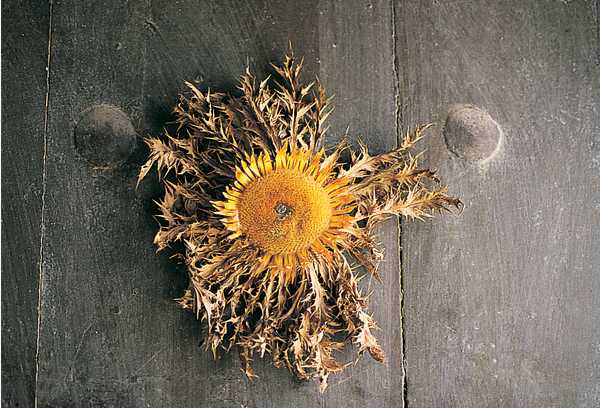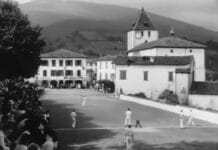Today is the Monday after Easter Sunday, when we Basques celebrate the Aberri Eguna, or Day of the Basque Fatherland. On this ever so special Monday, we’d like to share with you the story and legend behind the eguzkilorea. This humble yet powerful protective flower has, for centuries, if not millennia, been in charge of defending Basque homes from evil.
We’re doing so because we want to, not because it’s showed up in any international media outlet. And we’re doing so because early this morning, a regular reader of ours sent us a link to a blog she writes in order to share this story. We’re not much for believing in coincidences, and that’s why we can’t help thinking that this entry we’ve received, written on this date, has something to do with Aberri Eguna.
That’s why we thought, What does our traditional Eguzkilorea have to do with the Aberri Eguna? We’re sure many will think nothing at all, but we think that there is a truly important relationship:
Thousands of years ago, the first Basques to inhabit today’s Land of the Basques thought that Amalur, the Mother Earth, gave us this dry flower of the silver thistle (Carlina acualis) as a way to protect homes from all the evil the darkness could bring. About 120 years ago, in 1895, Sabino de Arana y Goirí created another symbol, the ikurriña, in order to protect and defend that land itself, Euskadi.
Yesterday, on the Aberri Eguna, the Ikurriña, that symbol of protection and identity was used by thousands of Basques on all six (inhabited) continents to remind the world, and ourselves, what our Homeland is. So it’s a good thing that today, Easter Monday, we remember this other great protective symbol of the Basques.
Note: the blog we found this story about the eguzkilorea has disappeared (it’s a shame how easily information can disappear in this digital era), so we found the same story on another blog, AmaiurZen. Check it out here in Spanish.
Eguzkilore
(John R. Bopp translation)
Today, I’d like to share something with you that has nothing to do with Shiatsu, or therapies, or martial arts, but that does have something do with Amalur Zen.
On the page “Sobre Amalur Zen”, I wrote that the name “Amalur” comes from Basques, and means “Mother Earth“. This is the story of how Amalur created the sun, the moon, and the “Eguzkilore” to protect humans from evil spirits, as is told by Basque mythology.
The legend says that at the beginning of time, when humans started to populate the earth, there was no sun and no moon, and men were immersed in a great darkness, frightened by the many creatures that came forth from the earth: bulls on fire, flying horses, enormous dragons, genies, and witches, etc. People lived in caves, fearful and anxious, until finally, in their despair, they decided to ask Amalur for help. Given their insistence in their prayers, Amalur told them:
“My children, you’re asking me to help you, and that is what I shall do. I shall create a lighted being that you will call Ilargi“.
And thus Amalur created the Moon, which, with its pale light, illuminated the night and scared off the creatures. At the beginning, the men were afraid of the light and stayed in their caves, not daring to come out. But then they saw that the creatures of the darkness fled from the light of the Ilargi, and they went out to celebrate, with great joy. But the fear of the genies did not last long, and little by little, the creatures of the darkness became accustomed to the light of the Ilargi, and didn’t take long for them to start climbing out of their chasms and start bothering the humans again. So, the people again turned to Amalur, this time asking her for something more powerful.
“Amalur,” they said, “we are very grateful for the gift you gave us of the mother Moon, but we need something more powerful because the genies won’t stop persecuting us.”
“Very well,” replied Amalur, “I shall create an even brighter being you shall call Eguzki.”
And thus Amalur created the Sun. That way, the Sun would shine by day and the Moon by night. It was so big, bright, and warm that even the men needed time to get used to it. Thanks to its heat and light, the plants grew, and more importantly, the genies and witches couldn’t get used to the great light during the day, and since then they could only go out at night.
But the men once again turned to Amalur to ask her for protection during the night, since the genies still came out of their chasms in the darkness of the night to bother them. And it was then that Amalur created a flower that was so beautiful, the beings of the night, upon seeing it, would believe it was the Eguzki itself and would flee in terror. That is the “Eguzkilore” (sun flower (not “sunflower”)). And to this day, this is the symbol that protects and defends homes from the evil spirits, witches, and genies of illness, storms, lightning, and other enemies of man.
Since that time, to this day, this flower is still sought, to dry it and hang it on the door of the home to protect it from evil spirits. It is popularly believed that the sorginak (witches) and lamiak (nymphs) could not enter into a home until they had counted all the leaves of the plant, but that they weren’t able to do so before dawn would break, forcing them back into their underground lairs. In other versions, the mere sight of the eguzkilore on the door would make them believe it was the sun itself, and that dawn was about to break, meaning they needed to retire to their caves.
The Eguzkilore is the flower of the silver thistle (Carlina acaulis), a perennial plant with a stiff stem and low height, about 20 cm (8 in). It grows close to the ground and blooms in the form of a rosette with short, spiny leaves. The flowery head is in the center of the rosette. It is known for not shrinking, always maintaining its beauty and freshness. It grows on sunny stony slopes, fallows, and mountain meadows.
For Eva, who believed in me and saw me shine, and who gave me a very special Eguzkilore.
Last Updated on Dec 20, 2020 by About Basque Country






























